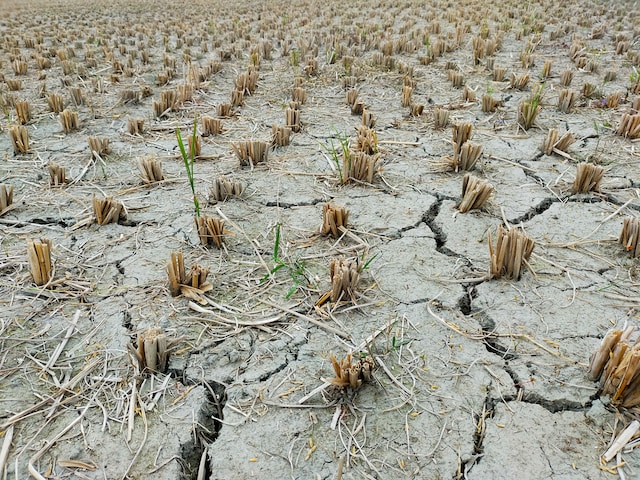Economic Impacts of Drought
Drought can cost people, businesses and governments money. These impacts may be local, and only affect those in the drought-stricken area, or they may be widespread and also affect people living outside the drought-affected area. Drought also has an adverse impact on different sectors, such as agriculture, energy production, tourism, and recreation and is even thought to have collapsed past civilisations [i].
Drought’s economic impact in agriculture
In the agricultural industry, dry conditions and lack of precipitation can damage or kill crops, negatively impacting farmers’ income. Crop loss also impacts consumers through increased food prices and the economic impacts of drought can be felt in other provinces and even countries.
The 2021 drought in Canada was considered to be a factor in the higher prices for Canadian beef and grain products in 2021 [ii]. Livestock producers are impacted by drought because of a lack of drinking water and poor pasture conditions as well as increased prices of feed for livestock.

A lack of food and water, or increase in the price of food and water, can lead to ranchers selling or slaughtering more animals from their herd. An increase in animals slaughtered early in a drought year may cause an initial decrease in meat prices due to overabundance of meat. However, this is often followed by an increase in meat prices as a drought persists, as there are less animals and the price to feed and water the animals has increased.
Grain farmers’ fields have reduced yields and smaller volumes tend to result in higher prices. In 2023, similar effects are playing out on a global scale [iii] with a resulting increase in food prices around in the world.

Drought’s economic impact on energy production
In 2014, primary energy production and power generation is estimated to have accounted for approximately 10% of global water withdrawals and about 3% of total water consumption [iv]. Drought, therefore, impacts thermal and nuclear [v] energy production, where there may not be enough water to cool the process, and hydropower production where there may not be sufficient water to produce power [vi].

Source: International Energy Agency, 2016, World Energy Outlook 2016. https://iea.blob.core.windows.net/assets/680c05c8-1d6e-42ae-b953-68e0420d46d5/WEO2016.pdf. Accessed 2023-09-08.
As an example in Canada, in the Northwest Territories in 2019, 46.8% of the power generated was from hydropower [vii]. In 2023, the Government or the Northwest Territories had to contribute a “temporary relief to electricity rates”, worth some $15.2 million, to offset the loss of hydropower resulting from low water flows [viii]. Due to the decreased energy production, there was a shortfall in power across the Territories that needed to be supplemented with diesel power generation. Diesel power generation is more expensive than hydropower generation and increases greenhouse gas emissions during combustion. This supplemental contribution was also necessary in 2014 for the same reason [ix].
Another example of drought having a negative financial impact on the energy industry is in 2001, when severe droughts in California and the Pacific Northwest significantly reduced hydropower generation. This resulted in tight electricity supplies and high prices. Power outages were largely avoided; however it is estimated the total regional economic impact of the drought was between US$2.5 – 6 billion [x].
Drought’s economic impact on recreation and tourism
Drought can also hurt the recreation and tourism industry. Businesses, such as water sport rental shops, may be financially impacted during a drought. Small businesses near a waterfront or in a vacation town that rely on a steady stream of tourists for business may also lose money [xi].
As climate variability increases in the future, the economic impacts of drought may be more prominent. Droughts can be expensive for consumers with increased food and energy prices, as well as cost the municipality, province and country where they occur. If a drought is severe enough, it may also have an impact on the overall GDP of a nation.
Sources:
[i] Zaveri, E.D., Damania, R., et al, 2023. Droughts and Deficits: The Global Impact of Droughts on Economic Growth. https://openknowledge.worldbank.org/server/api/core/bitstreams/8b8659c6-8087-46f2-907e-0d69a0a89d56/content. Accessed 2023-08-24.
[ii] Statistics Canada, 2021. Behind the Numbers: What’s Causing Growth in Food Prices. https://www150.statcan.gc.ca/n1/pub/62f0014m/62f0014m2022014-eng.htm. Accessed 2023-08-24.
[iii] World Economic Forum, 2023. Record temperatures are driving food prices higher. Here are some of the crops facing the biggest impacts. https://www.weforum.org/agenda/2023/08/climate-change-food-prices-drought/. Accessed 2023-08-24.
[iv] International Energy Agency, 2016. World Energy Outlook, 2016. https://iea.blob.core.windows.net/assets/680c05c8-1d6e-42ae-b953-68e0420d46d5/WEO2016.pdf. Accessed 2023-08-24.
[v] de Beaupay, F., 2022. EDF Expects Nuclear Output Cuts in Summer on Low River Levels. https://www.bnnbloomberg.ca/edf-expects-nuclear-output-cuts-in-summer-on-low-river-levels-1.1787838. Accessed 2023-08-24.
[vi] Wang, J., Schleifer, L. et al, 2017. No Water, No Power. https://www.wri.org/insights/no-water-no-power. Accessed 2023-08-24.
[vii] Statistics Canada, 2023. Provincial and Territorial Energy Profiles – Northwest Territories. https://www.cer-rec.gc.ca/en/data-analysis/energy-markets/provincial-territorial-energy-profiles/provincial-territorial-energy-profiles-northwest-territories.html. Accessed 2023-08-24.
[viii] Northwest Territories Power Corporation, 2023. GNWT introduces temporary electricity rate relief to prevent sharp increase to electricity bills. https://www.ntpc.com/about-ntpc/news-releases/2023/06/01/gnwt-introduces-temporary-electricity-rate-relief-prevent-sharp. Accessed 2023-08-24.
[ix] Canadian Broadcasting Corporation, 2014. N.W.T. to borrow money to cover cancelled power rate hike. https://www.cbc.ca/news/canada/north/n-w-t-to-borrow-money-to-cover-cancelled-power-rate-hike-1.2778988. Accessed 2023-08-24.
[x] Argonne National Laboratory, 2011. Analysis of Drought Impacts on Electricity Production in the Western and Texas Interconnections of the United States. https://energy.sandia.gov/wp-content/gallery/uploads/Drought-Analysis-Report-Final.pdf. Accessed 2023-08-24.
[xi] Dube, K., Nhamo, G., et al, 2020. What the tourism sector can learn from Cape Town’s drought. https://theconversation.com/what-the-tourism-sector-can-learn-from-cape-towns-drought-145789. Accessed 2023-08-24.
